How to Navigate a Brand Crisis: a Step-by-Step Guide
Table of contents
In our hyper-connected, always-on world, you must know how to manage a brand crisis. One wrong move can damage your credibility. It takes just one tweet, one negative review, or one controversial statement to send your brand reputation into a tailspin. Hopefully, with our step-by-step guide to brand crisis management, you’ll be able to survive any storm.
Handling a brand crisis well needs swift action and careful planning. You can spot problems early by using social listening tools to monitor brand sentiment and mentions. By staying proactive, transparent, and responsive, you can protect your reputation and even use a crisis to improve your brand image.
Nowadays, every customer can interact with a given brand. People can write negative opinions, spread stories about your product, or leave a 1-star review without any explanation.
The constant connection between brands and their followers gives more and more power to the latter.
That’s why bad news about the reputation crisis spread so fast across the web.
The good news is you can proactively prevent a crisis from occurring.
And if a crisis hits you, you can limit the scope of the damage or even turn the tables around and promote your brand.
How to detect a brand crisis quickly?
When it comes to detecting brand crises, it is a helping hand.
The data gathered by the social listening tools will be useful in many stages of managing the crisis.
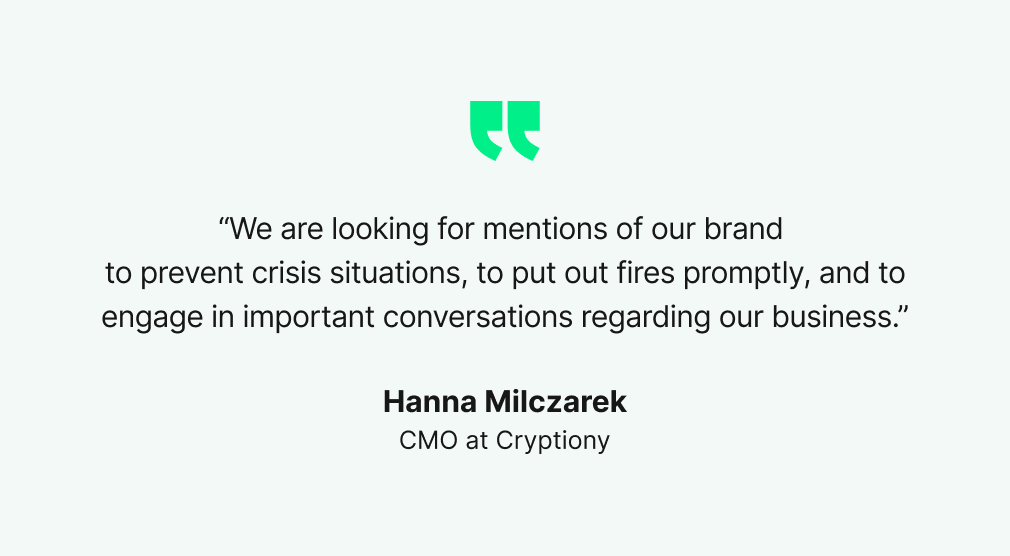
Discover our client’s success story — read the case study.
By monitoring social media platforms, review sites, and other online channels, you can gather valuable insights into how consumers perceive their brand.
Here are some ways you can use social listening to detect an upcoming crisis:
- Monitoring negative brand mentions
- Analyzing brand sentiment
- Identifying trends
- Tracking the context of a discussion
- Setting up storm alerts
Detect upcoming brand crisis!
Here you can see the rise of negative mentions according to the latest Marvel movie Ant-Man and the Wasp: Quantumania, which premiered on February 17:

The movie didn’t meet the viewers’ expectations. Brand24 tool detected it immediately.
As a result, unfavorable reviews negatively affect the overall reputation of Marvel:
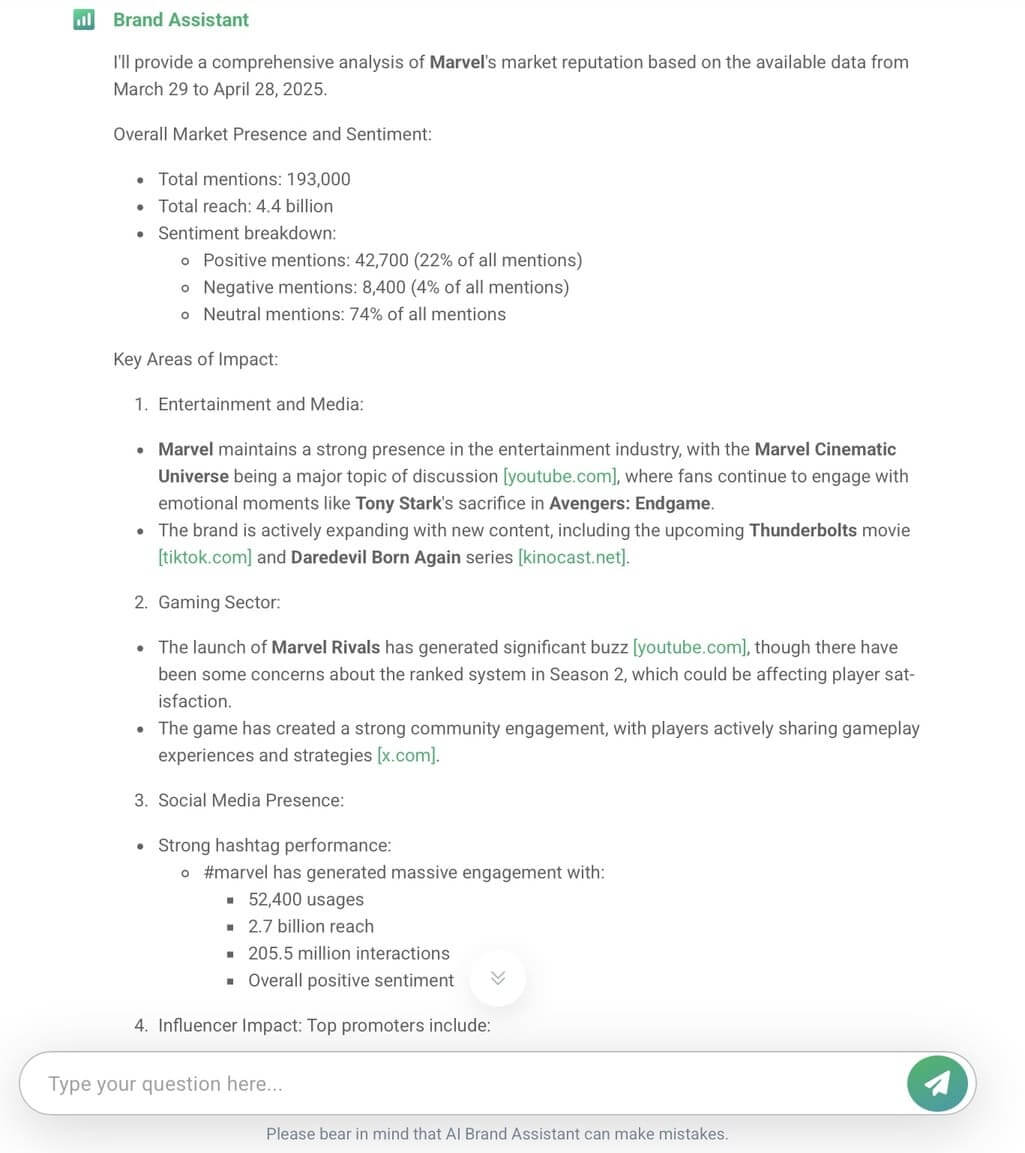
When it comes to detecting brand crises, the AI-based ‘Compare periods’ feature is a game-changer.
This function allows you to track and compare key metrics across different timeframes.
By doing so, you can identify trends and shifts in brand sentiment or volume of mentions that suggest a potential crisis brewing.
This early detection is crucial as it enables you to prepare or even prevent the crisis before it gains momentum.

Each crisis has its early warning signs. These include:
- An increase in negative mentions
- Changes in customer sentiment
- Negative customer feedback
- Decrease in sales and revenue
- Legal issues or regulatory violations
- Negative media coverage
If you notice any of these signs, start an internal investigation.
Monitor negative mentions!
How to prepare for a brand crisis?
Better safe than sorry — this saying is true not only when it comes to your health but also when we talk about protecting your company.
We can divide brand crisis management into three steps:
Step 1: Avoiding social media disasters altogether. I know it’s easier said than done, but it is possible.
Step 2: Prevent brand reputation crises from escalating. The faster you react to a crisis, the better the chance you can contain its effects.
Step 3: Dealing with a full-blown crisis. You can take all the precautions, but sometimes the crisis will just hit you. You have to be prepared for the worst-case scenario.
How do you manage various types of brand crises?
There is some common ground between all three types of brand reputation crisis management. You can implement some of the techniques in all three steps and make everything all right.
This step-by-step company crisis management guide will give you all the necessary answers!
Prevent brand crises!
01 Avoid brand crisis
The best way to manage a crisis is to avoid one altogether. One of the best ways to do that is by listening to online chatter.
It’s relatively easy when it comes to your earned media. All you have to do is keep track of all the notifications you receive.
Monitoring online conversations gets a bit tricky when the chatter happens on different channels. Constantly checking notifications on various social media channels and forums is a waste of time.
Sentiment analysis is your secret weapon. It will detect how people feel about your brand.

Are they happy with your product or service? Or maybe there are some aspects you could quickly improve?
Your customers will also share their negative experiences online. The good news is you can still change the perception of your company!
Once a user posts a negative comment, you have to act quickly. The faster you react, the lesser the chance the negative attitude will spread online.
You can even score some points by showing your excellent customer service skills and turning a negative comment into a positive one!
To do that, you must interpret the mentions correctly.
And AI features can be indispensable for that.
Have you heard about the AI-based emotion analysis by Brand24?
It helps to monitor and gauge the emotions that your brand evokes in those collected conversations. This insight is vital for recognizing negative sentiments that could escalate into bigger issues.
Plus, the tool also enables to monitor how these emotions change over time:

Another feature you should know is AI-based topic analysis. It can be helpful to identify specific themes or topics that are generating negativity among your audience.
By understanding these topics, you can proactively address and resolve issues before they become a dangerous crisis.
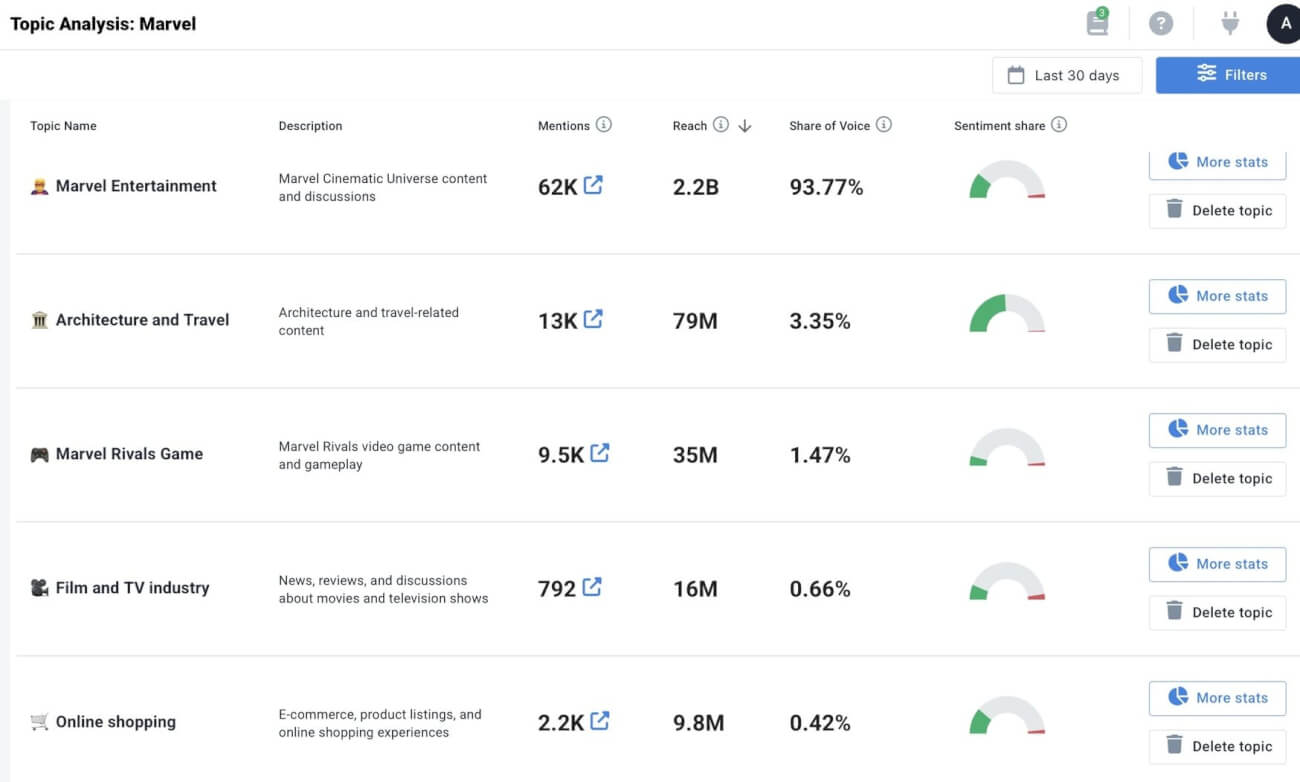
Monitor your online sentiment!
Brand24 gathers publicly available mentions containing your predefined keywords. The tool also offers different notifications system you could use to always be on top of things.
You can set up three types of notifications and one bonus solution.
Let’s start with notifications:
- Slack notifications. Every time there’s a new mention, you’ll receive a notification on your chosen Slack channel. If you use Slack daily, it’s incredibly convenient!
- Email notifications. You can add email notifications in the project settings. Determine how often you’d like to receive an alert. You can also set filters, for example, receive only mentions with negative sentiment or from a certain author.
- In-app notification. Brand24 offers an app for both Android and iOS devices.

Set up the rules at the beginning
Your brand is present on different online channels. You’re responsible for the tone of discussion and behavior of your followers.
The one guideline I like to implement on earned social media channels — your place, your rules.
Make it known from the beginning what behavior will and will not be tolerated. The rules should be visible. Don’t hesitate to take down all the offensive posts.
Another thing to make clear right at the beginning of your brand reputation crisis management plan is to set up the right expectations.
If you’re a small company, chances are you might not be able to respond to every negative comment quickly.
Be upfront with your customers and set a reasonable response time. Your audience won’t wait forever for a response, so try to make it within a couple of hours of posting a question or complaint.
Try to solve the problems as quickly as possible so the crisis doesn’t spread on the Internet.
Get instant notifications on your mentions!
02 Prevent the escalation
You might miss something in your communication or misjudge a threat to your brand reputation.
In that case, your job is to prevent the crisis from escalating.
It’s not the end of the world, but you have to put in some effort so that the crisis won’t spread across social media.
The first step is precisely the same as previously. Try to listen to your customers and reply to their complaints.
Unfortunately, you might have passed the point when this approach was enough. Now you need something extra.
Be transparent
Nothing works like honesty.
No one expects you to be perfect. There are real people behind your brand, and real people make mistakes.
Why do honesty and transparency work?
The simplest explanation is that people don’t like being lied to.
By telling the truth, you show your customers that you care about them and consider them part of your family.
Admit your mistake, apologize, and present a plan, or at least willingness, to change and repair the damage. Your customers will appreciate that and will spread the good news about your company.
Monitor your brand reputation!
Be thoughtful
Empathy can go a long way. Showing your unhappy customers that you care about their problems could even turn your critics into brand ambassadors.
Being thoughtful builds trust, a currency you can’t buy. The more your customers trust your brand, the more willing they are to forget about your mistakes.
Take a look at Adobe Customer Care:

Moreover, word-of-mouth is the most powerful form of marketing there is. Recommendations from customers, who experienced a problem that you managed to solve, are priceless.
Stay cool
While dealing with a crisis, emotions can get the best of you. That’s a mistake you can’t afford.
I know that it might be challenging to stay calm while a devastating situation might hit not only the affected brand but also its employees.
No matter what happens, do not lose your cool. Stay professional and keep the discussion on a civilized level.
To prevent a company crisis from escalating, show your human face!
Track the sentiment of your brand!
03 Deal with a full-blown crisis
Mistakes happen. Even if you do your best to avoid them, sometimes these mistakes can snowball into a full-blown company crisis.
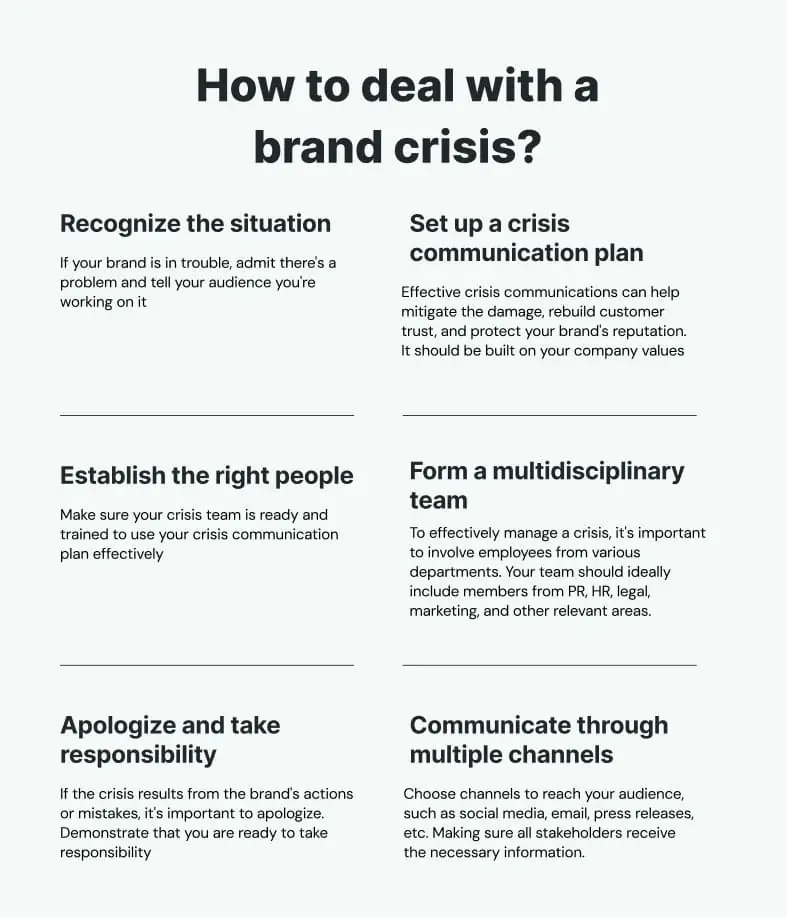
Bad news travels fast. Bad news online travels with the speed of light.
That’s why sometimes a company crisis will escalate before you even have a chance to prevent it.
But you can salvage your brand reputation even from a major scandal. You need to be prepared!
Recognize the situation
The first step in managing a brand crisis is acknowledging the problem and communicating that you are aware of the issue. You should demonstrate that your brand is taking the situation seriously and is working to address it.
Provide accurate information
It’s important to provide accurate and timely information to your team about the situation. Include what happened and how the brand was affected. This can help address any rumors or misinformation that may be circulating.

Discover our client’s success story — read the case study.
Set up a crisis communication plan
Effective crisis communications can help mitigate the damage, rebuild customer trust, and protect your brand’s reputation. It should be built on your company values.
Here you can read the crisis communication guide.
Detect upcoming brand crisis!
Crisis communication examples
- Adidas ended its partnership with Kayne West after his controversial statements:

- Ticketmaster apologized to Taylor Swift and all of her fans for the chaos when buying tickets for concerts:
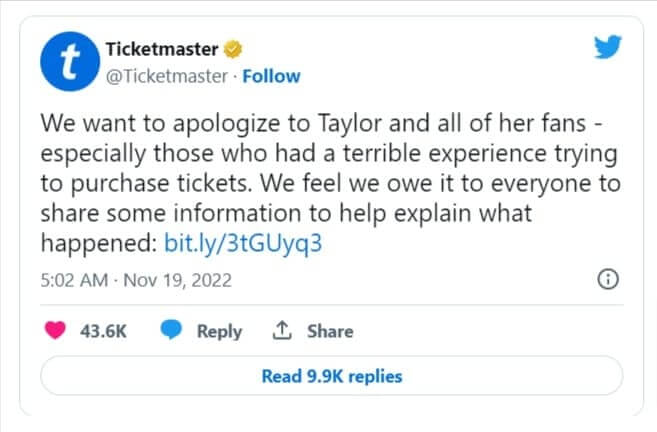
Establish the right people
And by right, I mean experienced managers. Train your crisis team on how to implement the crisis communication plan and how to communicate effectively during a crisis.
Another aspect of reputation crisis management is the accessibility of your social media. I know you trust your employees, but accidents happen.
If only a selected group of people have access to your social media accounts, you can make sure that you broadcast a consistent message across all your earned channels.
Moreover, you’ll limit the risk of accidentally posting messages not meant for your business account.
Just like British Airways did a few years back. The airline shared its competitor, Virgin Atlantic, Facebook post.
Form a multidisciplinary team
Managing a crisis could involve many employees from different departments.
Your team should consist of team members from PR, HR, legal, marketing, and other relevant departments.
These specialists should know how to contain the crisis and limit the damage.
It’s essential to train your brand reputation crisis management regularly.
Be prepared for the worse. Train how to deal with unusual and highly demanding situations so that when the real crisis hits, you’ll know what to do.
Apologize and take responsibility
If the crisis results from the brand’s actions or mistakes, it’s important to apologize. Demonstrate that you are ready to take responsibility. It will help rebuild trust with customers and stakeholders. Make an official statement if necessary.
Communicate through multiple channels
Choose channels to reach your audience, such as social media, email, press releases, etc. This can help ensure that stakeholders receive the information they need and can help address any concerns or questions they may have.
Listen to what customers say about your brand!
Conclusion
A brand crisis is not the end of the world! You can even turn a crisis situation into a win for your brand.
Remember that everybody makes mistakes. Public opinion is sensitive nowadays. So you have to watch out for the most common causes of the crisis:
- Customer service issues
- Cybersecurity breaches
- Social media mishaps
- Product recalls
- Misconduct by company executives or employees
- Legal issues or regulatory violations
Not every company, though, can show its human face and resolve a crisis so that people trust them again.
Although managing a crisis can be challenging, following some best practices will help you keep things under control:
- Monitor the situation closely
- Stay calm and composed
- Respond effectively and quickly
- Have a crisis communication plan in place
- Learn from the experience
Start with the simple tactic — listen to what people say about you. There is a great chance you won’t need anything else. Start a free trial!
Related articles


![Guide to Brand Monitoring + TOOLS [2025 update]](https://brand24.com/blog/app/uploads/2019/08/Top-10-brand-monitoring-tools.png)


![7 Steps for Effective PR Crisis Management in 2025 [Infographic]](https://brand24.com/blog/app/uploads/2024/04/PR_Crisis-600x335.webp)
![How to Protect Your Reputation Online? 5 Steps [2025]](https://brand24.com/blog/app/uploads/2024/05/Protecting-Online-Reputation-600x335.webp)
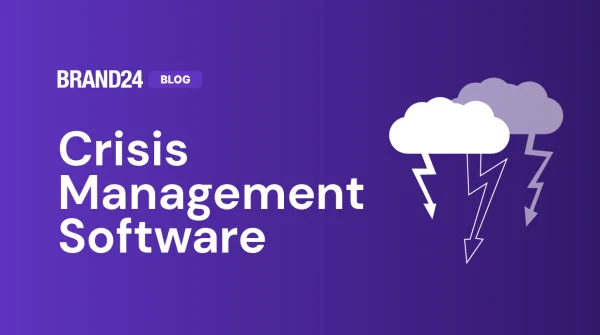
![How to Measure Crisis Performance? [2025]](https://brand24.com/blog/app/uploads/2024/06/crisis_performance-600x335.webp)